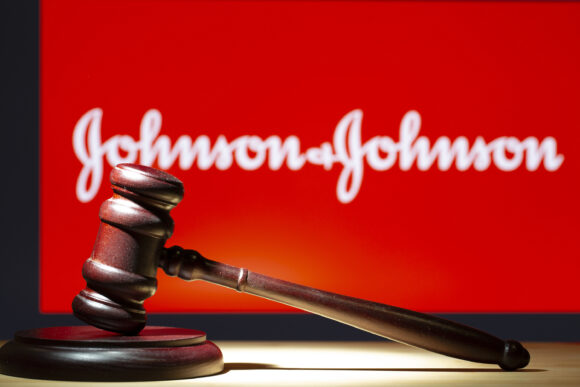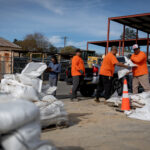Eron Evans died in 2016 at 41 of ovarian cancer, leaving behind two daughters. Her grieving mother, Darlene, blames Johnson & Johnson’s Baby Powder – and she’s pursuing a lawsuit her daughter started a decade ago, alleging the company’s talc caused the deadly illness.
The 71-year-old Houston-area grandmother has drained her savings caring for the girls, she said. Now she and tens of thousands of other claimants face a July 26 deadline to vote on J&J’s third attempt at a controversial bankruptcy maneuver that would cap its liability and set up a fund to pay victims.
“I don’t know how much longer I can carry on,” Evans told Reuters. “I feel pressure that I should probably vote ‘yes.'”
After being rebuffed twice by federal courts, the $350 billion healthcare giant is attempting again to end the litigation in a so-called “Texas two-step” bankruptcy. The maneuver involves offloading its talc liability onto a newly created subsidiary, which then declares Chapter 11. The goal is to use the proceeding to force all plaintiffs into one settlement – without requiring J&J itself to file bankruptcy.
But the company needs the votes of 75% of claimants before the subsidiary can ask a bankruptcy judge to impose the deal on all of them. J&J faces lawsuits from more than 61,000 plaintiffs but the figure swells as high as 100,000 when counting claimants who haven’t sued, according to Erik Haas, J&J’s global vice president of litigation. The company maintains its talc products are safe and do not cause cancer.
Some plaintiffs’ lawyers, including Evans’, are urging their clients to support the settlement. Her attorney, Jim Onder, called the offer a good-enough deal to take, given the alternative. Some of his clients, he said, are dying while the legal fight drags on.
“While no amount of money is ever enough for the horrific suffering these women have undergone, this is an opportunity to get money now and avoid many years of additional protracted litigation,” Onder told Reuters.
But a coalition of other plaintiffs’ lawyers is fighting back, saying J&J’s bankruptcy maneuver should not be legally allowable – given that the company itself is immensely profitable – and that its $6.48 billion offer is too low.
In a June 21 email to plaintiffs’ lawyers seeking their support, J&J’s lead settlement attorney, Jim Murdica, accused attorneys leading the opposition of turning settlement talks into a “flame throwing war” of overheated rhetoric aimed at J&J and fellow plaintiffs’ lawyers supporting its plan. The company alleges the holdout lawyers oppose its proposal out of greed, to extract hundreds of millions of dollars in additional fees that would be unavailable in a bankruptcy deal.
The lawyers who oppose J&J’s plan, in turn, accuse the company of abusing the bankruptcy system to deny plaintiffs’ right to pursue a jury trial or decide individually whether to settle. And they say J&J is rigging the settlement vote by recruiting clients with bogus claims, arising from cancers with less-proven links to talc, that the company would never pay outside of bankruptcy.
In a statement to Reuters, J&J’s Haas dismissed such allegations and called its proposed settlement “one of the largest in the history of tort litigation.” J&J, he said, “firmly believes its offer is fair and reasonable.”
This summer’s battle for votes, replete with the barbed rhetoric of a political campaign, could have profound implications on the fate of the Texas two-step as an emerging U.S. corporate defense strategy.
J&J is among a handful of major corporations that have tried the gambit, which seeks to resolve mass litigation in bankruptcy courts without exposing the company being sued to the consequences of Chapter 11, which can include damaging its market value and credit rating. The strategy gets its name from a Texas law that enables the maneuver by allowing a legally imperiled company to split into two new firms: One to absorb liability and seek bankruptcy protection, the other to continue with business as usual.
Reuters has detailed the secret planning of Texas two-steps by J&J and other corporations in a series of investigative reports.
The creative legal maneuver, which J&J first undertook in October 2021, once promised to revolutionize the way corporations handled mass tort claims, providing a simple way to jettison the threat of jury trials. But J&J and other firms have met stiff resistance from some plaintiffs and judges, and none has succeeded in reaching a bankruptcy settlement after years of trying.
J&J says it now has “overwhelming” support from plaintiffs’ lawyers who have agreed to recommend the settlement to about 80,000 claimants they collectively represent, largely those with ovarian cancer.
Andy Birchfield from the law firm Beasley Allen is leading the opposition and pushing for a much larger settlement. He told Reuters he hopes to muster about 25,000 votes to block the bankruptcy, about half of which are his own clients.
J&J’s Haas said Beasley Allen’s “obsessive anti-vote campaign is a last-gasp effort to stop the claimants from speaking for themselves.”
In his June email seeking settlement support, J&J settlement attorney Murdica called for an end to “hyperbole and unnecessary personal attacks” by opposing lawyers. He told Reuters the message resulted in a subsequent “factual and accurate discussion” with some plaintiffs’ attorneys. Haas said some subsequently signed onto J&J’s proposed deal.
A bankruptcy settlement offers all claimants fairer compensation than trial courts, where most are likely to get nothing, Haas said.
A key contention in the litigation, which dates back more than 15 years, is that customers contracted cancer through exposure to asbestos-tainted talc in J&J’s Baby Powder. Mined talc can contain asbestos, a known carcinogen. J&J says its talc does not contain asbestos.
J&J has won most cases that have gone to trial. But its losses include a Missouri verdict for ovarian-cancer victims that ultimately cost J&J $2.1 billion. A plaintiff with mesothelioma – a deadly cancer that attacks a thin layer of tissue that covers many internal organs – won a $260 million judgment from an Oregon jury in June. J&J vowed to appeal.
In the previous two Chapter 11 cases, a J&J subsidiary declared bankruptcy in hopes that claimants would vote to approve the settlement after the filing. This time, J&J hopes to garner support from 75% of claimants and have a subsidiary file a “prepackaged” bankruptcy with the necessary votes in hand.
Under this bankruptcy plan, should it survive legal challenges, payouts for individual cases would be determined by administrators of a trust created to pay claims. The average payout for an ovarian cancer claim is likely to fall between $75,000 and $150,000, according to an estimate by J&J’s subsidiary in bankruptcy plan documents reviewed by Reuters.
Birchfield and his allies accused the company in a statement of trying to “stuff the ballot box” by reaching settlement agreements with lawyers representing claimants suffering from diseases with no scientific link to talc. They allege J&J is paying off these weak cases, which it would never otherwise settle, in exchange for the votes it needs.
Haas, J&J’s litigation executive, called the ballot-stuffing argument a smear tactic and said the company has “no choice but to propose a plan that addresses claims beyond ovarian cancer” to achieve “global peace.” He said Birchfield and other plaintiffs’ lawyers have filed such cases in trial courts.
Birchfield said he has no plans to pursue cases in trial courts that don’t support an ovarian cancer diagnosis, and that his office is still seeking medical records for some claims. His firm’s only objective, he said, is to get “fair value” for its clients.
While J&J recruits votes for a deal, Birchfield has launched his own campaign, sending emails to fellow plaintiffs’ lawyers urging them to hold fast against J&J’s plan. A June email reviewed by Reuters called J&J’s effort a “scam” to evade accountability.
“The stakes could not be higher,” the email said.
A Change of Venue
For J&J, the enduring allure of Chapter 11 lies in the fact that bankruptcy judges, unlike trial-court judges, can enforce global settlements that permanently halt all related lawsuits and forbid new ones. Otherwise, any settlement with some clients would still leave holdouts or future plaintiffs with the right to sue – and leave J&J exposed to the kind of multibillion-dollar verdicts that made it resort to a two-step in the first place.
J&J’s previous two-step bankruptcies in New Jersey, where the company is headquartered, were rejected on the grounds that its subsidiary lacked the “financial distress” required for bankruptcy protection because it could access billions of dollars in J&J’s money to pay claims. So J&J’s subsidiary plans to file in Texas this time, where some legal experts say it could get a different opinion on the financial-distress standard.
The first rejection of J&J’s strategy on those grounds came from the 3rd U.S. Circuit Court of Appeals in Philadelphia, which ruled against its initial two-step bankruptcy in January 2023.
J&J’s subsidiary nevertheless filed a second bankruptcy in April 2023. The case went to U.S. Bankruptcy Judge Michael Kaplan in New Jersey, the same judge who had ruled in favor of J&J’s first two-step before the appeals court rejected it.
This time, Kaplan was skeptical. J&J had reduced the amount of money backing its subsidiary from about $61.5 billion in the first bankruptcy to $30 billion in the second in an effort to convince the court that the subsidiary meets the financial-distress standard. Kaplan said the reduction in money available to J&J’s subsidiary appeared “manufactured” to get around the appeals court’s ruling and decided to dismiss the bankruptcy in July 2023 for failing to meet the appeals-court standard that the subsidiary’s distress must be “imminent” and “immediate.”
The judge, however, urged J&J and claimants to “build upon the remarkable progress” made toward reaching a settlement and consider pursuing a resolution in another kind of bankruptcy proceeding.
‘Fraudulent’ Claims?
J&J believes it will get the claimant support it needs for its third two-step. The company removed some of the opposition by settling – outside of bankruptcy court – with claimants who had previously helped derail its Chapter 11 plans.
By May, J&J had reached agreements to settle almost all claims from people with mesothelioma. J&J declined to disclose the total it paid but sources familiar with the matter said it was about $2 billion. In June, J&J agreed to pay about $700 million to U.S. states alleging the company misled consumers about the safety of its talc products.
The majority of the remaining cases involve ovarian cancer. The claims arising from that disease and mesothelioma have been considered the strongest cases by plaintiffs’ lawyers because scientific evidence, while mixed and disputed by J&J, links the illnesses to talc.
Birchfield alleges J&J is weaponizing thousands of “fraudulent” claims related to other diseases – including cervical, vaginal and uterine cancers – as a strategy to overwhelm the objecting votes of ovarian-cancer plaintiffs.
The total number of claims allegedly involving diseases without clear connections to talc isn’t known. But it could be enough to decide the outcome of a potentially close vote based on J&J’s estimates of total claims.
J&J recruited one key plaintiffs’ lawyer who had initially opposed its two-step bankruptcy in part by agreeing to settle in Chapter 11 with about 9,000 of his clients with uterine cancer, according to the attorney’s testimony in J&J’s second subsidiary bankruptcy. That lawyer was Onder, who represents a total of 21,000 clients, including those with ovarian cancer.
That’s a potentially decisive voting bloc for J&J. Haas said in a May investors call the company faces between 85,000 and 100,000 total claims, “depending upon the ultimate process that we go through in vetting those claims.”
Birchfield argues J&J has little incentive to weed out bogus claims because they could provide the critical ‘yes’ votes it needs for a Chapter 11 settlement.
Onder first agreed to support J&J’s settlement during its second bankruptcy attempt. Under questioning at the time from another plaintiffs’ lawyer opposing the deal, Onder acknowledged that J&J had agreed to pay his clients for uterine-cancer claims it wouldn’t otherwise settle outside of bankruptcy.
J&J is actively recruiting to drive up the number of claims, Birchfield says.
“Attention talcum powder users!” declares one ad running on YouTube and paid for by a J&J subsidiary. “Have you had ovarian or gynecological cancer?” J&J’s settlement “will pay those who believe they got sick from using talc products,” the ad continues. “You have until July 26, 2024, to vote to accept or reject the plan.”
The ad directs potential claimants to a website that says J&J’s plan covers “any talc-related” claims involving “bodily injury, death, sickness, disease, emotional distress, fear of cancer, medical monitoring, or other personal injuries (whether physical, emotional, or otherwise).” There’s no guarantee any particular claim will be paid, the site says.
The ad is part of a required effort when soliciting votes on a bankruptcy plan to alert potential claimants, Haas said.
Birchfield takes issue with J&J’s solicitation of claims beyond ovarian cancer in the campaign, which spans television, radio, newspapers and online media. The intent of such efforts is to rig the vote, Birchfield argues.
“The magical appearance of tens of thousands of unsubstantiated cases could dilute the entire pool of plaintiffs” and provide the votes J&J needs, Birchfield and another attorney warned in a May email blast urging other lawyers to fight J&J’s settlement.
‘Pure Greed’
J&J’s lawyers have launched counterattacks on attorneys representing the holdouts, especially Birchfield. The company alleges Birchfield and his firm are undermining their clients’ best interests to get a bigger payout for themselves.
Plaintiffs’ lawyers commonly charge their clients contingency fees – a cut of any settlement or trial judgment. The lawyers’ share is often a third, though it varies.
Birchfield charges 40% of a settlement or judgment. But he and other lawyers also stand to collect additional compensation for their work on a steering committee overseeing most of the trial-court cases J&J faces, which are consolidated in a New Jersey federal court. The additional fees and expense reimbursements could total between 8% and 12% of any settlement, according to Birchfield and a court filing.
Haas calls such fees a “tax” and “windfall” unavailable to Birchfield in bankruptcy, attributing their opposition to “pure greed.”
Birchfield maintains he puts his clients’ compensation before his own.
In a separate line of attack, J&J has asked the federal judge overseeing more than 57,000 talc legal actions, also in New Jersey, to ban Birchfield from the litigation.
The company alleges Birchfield and a former J&J attorney had formed an improper alliance to present a proposal for a much larger $19 billion settlement, which at the time included the since-settled cases from U.S. states and mesothelioma claimants. Haas called the settlement proposal “delusional” and the partnership a “shockingly egregious” violation of attorney-client privilege between J&J and its former lawyer. Birchfield dismissed the allegation as a baseless effort to bully his clients.
‘Ridiculous’
Elizabeth Onekalit, 44, is among the clients of Birchfield’s firm who oppose J&J’s proposal.
“It sounds like it’s a ton of money,” she said. “But when it comes down to it, there are so many people that were affected by this. It’s just not adequate.”
She was 28 when an oncologist diagnosed her with stage-four ovarian cancer at a Denver hospital in 2008, she said. She blames Baby Powder.
The disease had spread to her stomach, lungs and lymph nodes. She had her ovaries removed and endured chemotherapy. She’s now in remission, she said, and struggling to conceive a child through in vitro fertilization. She doesn’t understand how J&J can keep filing multiple bankruptcies to delay compensating victims and force them into one settlement.
“Honestly, it seems like a joke,” Onekalit said of J&J’s plan for a third bankruptcy. “It’s just ridiculous. They don’t want to take care of the people they hurt.”
Haas said J&J empathizes with Onekalit and all claimants with cancer but denied the company caused it.
Evans, the Texas grandmother who cared for her late daughter’s children, is angered by J&J’s repeated bankruptcy maneuvers. But she said she might support the settlement anyway because she’s weary of the endless legal battle and worries about fellow plaintiffs who could also use the money.
Regardless, Evans said, the proposed payout doesn’t amount to justice.
Baby Powder, she said, had been a staple in their home. She had grown up using it herself and used it on all of her children. “I doused them in it,” she said.
She thinks about how her daughter missed so many milestones in her children’s lives.
“You’ve got to ask yourself: What’s the price tag on that?”
Was this article valuable?
Here are more articles you may enjoy.



 CEO Sentenced in Miami to 15 Years in One of the Largest Health Care Fraud Cases
CEO Sentenced in Miami to 15 Years in One of the Largest Health Care Fraud Cases  Louvre Tightens Security After $102M Jewel Heist, Installs Bars on Infamous Window
Louvre Tightens Security After $102M Jewel Heist, Installs Bars on Infamous Window  UPS Ripped Off Seasonal Workers With Unfair Pay Practices, Lawsuit Alleges
UPS Ripped Off Seasonal Workers With Unfair Pay Practices, Lawsuit Alleges  California Hit With Powerful Storms Just as Holiday Travel Ramps Up
California Hit With Powerful Storms Just as Holiday Travel Ramps Up 

